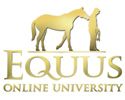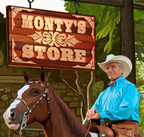I have a mare with Moon Blindness (uveitis). She is functionally blind with limited vision (shadows). She tracks sound and my voice well. My question is, "How do I perforn the 'Join-Up and Follow-Up' procedures with her? She's a sweet mare and I'd like to develop her abilities to a greater extent. I'd welcome any advice.
Rewards
Subscribe to Equus Online University and become a part of Monty's worldwide mission to leave the world a better place for horses and for people too.
Students automatically gain access to special rewards, such as exclusive discounts at the Monty Roberts Online Shop. Visit Monty Roberts Online Shop.




Hello Jack,
I am so sorry that your question has not been selected for Monty's educational column to date. Since Monty cannot answer all the hundreds of questions he receives weekly, we select the ones with common themes, and your challenge is quite unusual.
Unfortunately, no professional trainer can legally give advice on dealing with a sight-impaired horse, due to the fact that if we were ever asked the question whether we had put you in a safe situation, we would have to answer ‘no’.
Without working with the horse ourselves, and thus ensuring the safest possible environment, we can only ask you to get professional help with your horse and make sure you always place both yourself and your horse in a safe situation. Flight animals are dependent on their vision for many reasons, and your horse will have adapted their behavior to compensate for this lost sense.
When working with blind horses safety concerns are maximized and it is natural for horses who are blind to be more vigilant and less trusting than horses with good vision, as described in Monty's textbook excerpt below.
Equine Vision (Excerpt from From My Hands To Yours by Monty Roberts)
It is very important for the student of my methods to know about the primary elements of the horse’s vision. The eyesight of the horse and the information the horse receives through his eyes are directly connected to the knowledge of his language and responses to his environment. Much of the language of the horse is learned; it is not all instinctual.
I received two horses at Flag Is Up Farms to be started. One was born, and still is, completely deaf; the other was born blind. The blind horse was rescued and subsequently had eye surgery to remove cataracts. From that time on, he had limited vision, the depth and range of which were difficult for us to judge. The deaf horse responded to Join-Up in an average time, reading all the signs and responding to me normally. The blind horse had very little information about his own natural language and was unable to understand what my gestures meant, having spent the early part of his life blind.
Because of this experiment, I had proof that not only is their language silent, but it is mostly learned. First, the experiment showed that the natural language of the horse is silent. Second, it proved that very little of it is instinctual, as most is passed on, mare to foal, and between herd members.
Man and other predators have forward vision with their eyes set on the front of the head with a restricted arc of vision, but binocular. The horse’s eyes are among the largest of any land mammal and because they protrude from the side of the face, they have a very wide field of vision, 350 degrees. About 65 degrees of the 350-degree field of vision are binocular and the remaining degrees are monocular, so there is no depth of focus in approximately 285 degrees of their vision. A shadow could be a hole in the ground which accounts for horses often jumping over shadows.
The structure of the eye gives the horse about 50 percent magnification. Where we see a small plastic bag in the hedge, the horse sees a massive white object, which is moving and possibly dangerous. As I have mentioned, the horse has developed an instinctual reaction to danger, which is to flee. Only when he senses he is at a safe distance will he then take a second look, reassessing the situation. This is why it is so important not to get angry with a horse when he responds adversely to something we perceive as harmless and small.
Each eye of the horse individually records information which does not necessarily translate to the other brain hemisphere. Unlike the human, the horse has a limited ability to cross-reference information taken in through each eye. This is why a horse accustomed to being mounted on the nearside may take fright when mounted on the offside. Correct handling of a horse should consider this aspect of his physiology. A horse handled more on the nearside will often be less desensitized on the offside.
Scientists maintain that the horse does have two narrow blind spots. One is immediately behind him in an arc of about 5 degrees, and the other is on the forehead and up to 6 feet (approx. 2 meters) in front of him and beneath his nose. If the horse is attacked from behind, he can defend that approach with his hind feet. Therefore, caution should always be taken when approaching a horse from behind, as it is possible you will be viewed as an intruder into an area difficult for the horse to fully assess.
The flight animal’s eyesight is highly evolved to identify moving objects. Obvious-ly, this is linked to survival. He will often be alarmed by shapes or moving objects for which he has no previous reference. Even static objects can cause alarm if seen to resemble a predator. When working around a horse, I always attempt to move smoothly and with consistent speed so as not to be associated with the aggressive movements of a predator.
Good luck and please remember to make sure you and your horse stay safe and enjoy working together!
Kindest regards,
Monty Roberts Support Team
I thought perhaps this would help answer my question however my horse is similar but different(as always ) to the horse above.
He is 12 years old and had surgery for uveitis on his right eye last year,unfortunately this has left him blind in this eye,however,remarkably ,he rides out alone in traffic and jumps without appearing fearful or different,he seems to be adapting well although i know in his field or in his stable he will knock into things on his bad side that he can't see.
My question is ,as i get more experienced with other horses doing join up would i be able to try this on my horse?His main problem would be the initial laps in the round pen on his right side,could i adapt this to try all circles on the left lead?